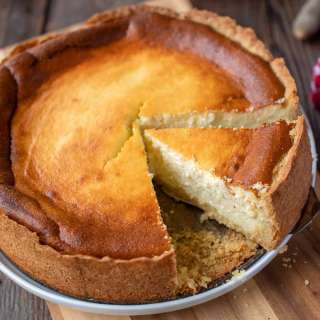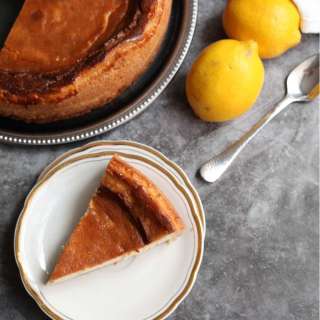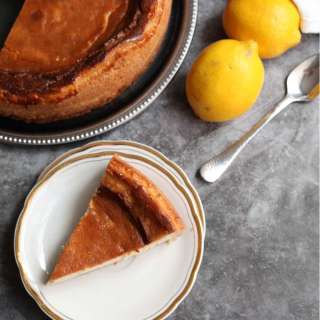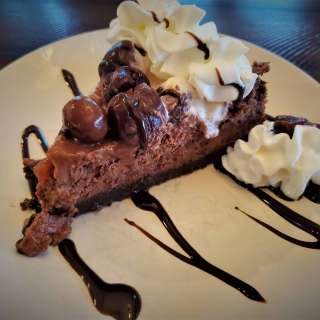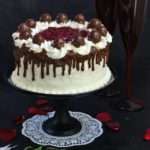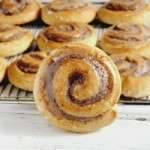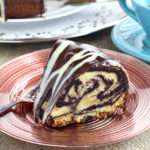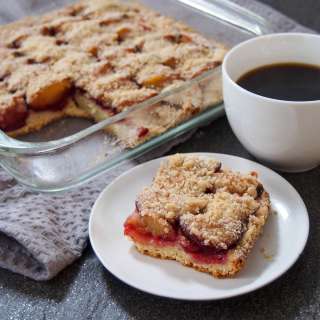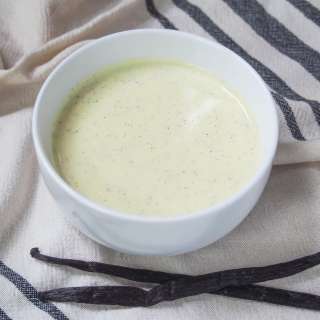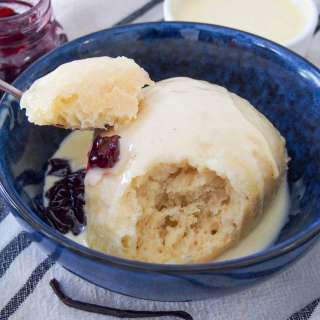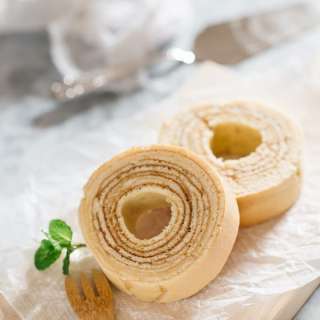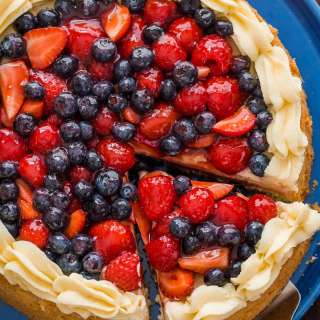
Käsekuchen (German Cheesecake)
User Reviews
5.0
6 reviews
Excellent

Käsekuchen (German Cheesecake)
Report
Käsekuchen (German Cheesecake) is a light, not-too-sweet but absolutely delicious dessert. It features a lovely shortbread crust and dense quark filling with hints of vanilla and lemon.
Share:
Ingredients
Crust:
- 190 grams (1 ½ cups) all-purpose flour
- 50 grams (¼ cup) granulated sugar
- Pinch kosher salt
- 85 grams (6 tablespoons / 3 ounces) unsalted butter room temperature
- 1 large egg beaten
Filling:
- 55 grams (4 tablespoons / 2 ounces) unsalted butter room temperature
- 150 grams (¾ cup) granulated sugar
- 3 large eggs separated
- 45 grams (⅓ cup) cornstarch
- 2 teaspoons vanilla extract
- 1 teaspoon grated lemon zest from about ½ a large lemon (optional)
- 450 grams (2 cups) quark or farmer cheese
- ¾ cup heavy cream
Add to Shopping List
Instructions
Crust:
- Preheat the oven to 350°F (180°C) and place the rack in the lower third of the oven. Grease the inside of a 9-inch springform pan. Line the bottom with a parchment paper round and grease the paper. Set aside.
- In a large mixing bowl combine the flour, sugar, and salt. Add the butter and the egg.
- Stir to combine and press the dough together until it forms a smooth ball. Wrap the dough in plastic wrap and chill for 30 minutes in the refrigerator while you prepare the filling.
Filling:
- In the bowl of an electric mixer fitted with the paddle attachment, beat together the butter and sugar until smooth and creamy, about 1 to 2 minutes. Beat in the egg yolks, then the cornstarch, vanilla extract, and lemon zest, if using, and beat to combine.
- Add the quark and heavy cream, and beat until smooth. In a separate mixing bowl, beat the egg whites to stiff peaks (by hand with a whisk or use your electric mixer with the whisk attachment). This will take about 2 to 3 minutes with an electric stand mixer at medium-high speed. Fold the beaten egg whites into the cheesecake batter.
Assembly and Baking:
- Take the chilled dough out of the refrigerator. Break it into smaller pieces and press it into the bottom and sides of the prepared springform pan.
- Pour the prepared filling into the crust. Transfer the pan to the rack on the lower third of the oven, and bake for 60 minutes.
- Then crack open the oven door and let it sit in there for another 10 to 15 minutes. The edges should be browned and the center will wobble a bit if you gently shake it, but will set as it cools. The center will also start to settle and sink as it cools.
- Remove from the oven and carefully remove the edges of the springform pan (if greased properly they should come right off). Cool completely on its base at room temperature. Transfer the käsekuchen off the springform pan base (peel off the parchment paper as well) onto a serving dish.
- Dust the top with powdered sugar and serve with fresh lightly sweetened whipped cream (schlagsahne) and berries, if desired.
Notes
- Ideally, bake this German cheesecake 1 day in advance and refrigerate it overnight for the most optimal results.
- Store leftover käsekuchen in an airtight container in the fridge for up to 5 days. You can also individually wrap slices of German cheesecake with plastic wrap, transfer to a freezer bag and freeze for up to 1 month. Thaw completely in the refrigerator before eating.
- When pressing the dough into the pan to form the crust, it may only go about 1 ½ inches up the sides of the pan, and that’s fine. Just make sure the edges look even. You can use the bottom and sides of a dry measuring cup to press along the bottom and edges to help even out the thickness.
- The total time in the recipe card doesn’t include cooling time, as that can and will vary. The serving size can also vary depending on how small or large you prefer your slices, but the nutritional information is based on 12 slices of käsekuchen.
- Quark is a type of fresh cheese, sometimes called farmer cheese or curd cheese. In Austria it's called topfen, in French it's fromage blanc (white cheese) or fromage frais (fresh cheese), in Polish it's twaróg, in Czech and Slovak it's tvaroh, and in Russian it's tvorog (творог). German-style quark has more of a creamy texture than Russian tvarog, which is a bit more dry and crumbly (but this is usually what I use for my recipes requiring quark because it's what I can find). In the United States you will often find it labeled as farmer's cheese. Any of those labels or names will work for this recipe. If you can't find any of the above, pureed cottage cheese, whole-milk ricotta, or Greek yogurt should be acceptable substitutes though I haven't tested these myself.
Nutrition Information
Show Details
Calories
335kcal
(17%)
Carbohydrates
36g
(12%)
Protein
11g
(22%)
Fat
17g
(26%)
Saturated Fat
10g
(50%)
Polyunsaturated Fat
1g
Monounsaturated Fat
2g
Cholesterol
108mg
(36%)
Sodium
44mg
(2%)
Potassium
131mg
(4%)
Sugar
19g
(38%)
Nutrition Facts
Serving: 12servings
Amount Per Serving
Calories 335 kcal
% Daily Value*
| Calories | 335kcal | 17% |
| Carbohydrates | 36g | 12% |
| Protein | 11g | 22% |
| Fat | 17g | 26% |
| Saturated Fat | 10g | 50% |
| Polyunsaturated Fat | 1g | 6% |
| Monounsaturated Fat | 2g | 10% |
| Cholesterol | 108mg | 36% |
| Sodium | 44mg | 2% |
| Potassium | 131mg | 3% |
| Sugar | 19g | 38% |
* Percent Daily Values are based on a 2,000 calorie diet.
Genuine Reviews
User Reviews
Overall Rating
5.0
6 reviews
Excellent
Other Recipes
